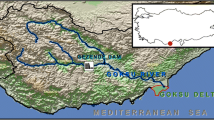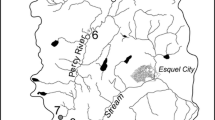Abstract
A new policy for wetlands conservation in France induced the development of research on the main functions of these ecosystems. This paper summarizes the results of four studies initiated in the Seine River basin by scientists, the regional water agency and a water supply syndicate to assess some of the functions of wetlands, mainly of riverine wetlands. One was directly conducted at the scale of the whole basin, focusing on the role of wetlands in water supply, flood control and nutrient retention. A second one was centred on the importance of waterbodies more or less connected to the channel for fish communities and on the role of flooded grasslands for the reproduction of pike. From the results obtained in large sectors of the fluvial corridor, a method is proposed for a regionalization of the hydrosystem. Two other approaches were tested in large areas of fluvial corridors to classify nitrate removal capacities of riverine wetlands through the identification of physical and biological indicators or modelling. What emerges from these studies is the necessity to undertake a common classification of wetlands on a hydrogeomorphic basis and then to develop multifunctional assessment in reference zones from the identified indicators or tested models.
Similar content being viewed by others
References
Adamus, P. R. & L. T. Stockwell, 1983. A method for wetland functional assessment. Vol. 1: critical review and evaluation concepts. Report FHWA IP.82.24, U.S. Department of Transportation: 171 pp.
Adamus, P. R., 1988. The FHWA/Adamus (WET) Method for Wetland Functional Assessment. In Hook, D.D. (ed.), The Ecology and Management of Wetlands, vol. 2, Timber press, Portland: 128-136.
AREA, Commission de bassin Seine-Normandie, 1992. Cartographie de synthèse des Schémas départementaux de vocation piscicole et des ZNIEFF (Zones Naturelles d'Intérêt Ecologique Floristique et Faunistique) humides du bassin Seine-Normandie. Définition des secteurs d'intérêt écologique majeur préalablement à des interventions d'aménagement: 64 pp.
Bailey, R. G., 1984. Testing an Ecosystem Regionalization. Envir. Mgmt 19: 239-248.
Barbier, E. B., M. Acreman & D. Knowler, 1997. Economic Valuation of Wetlands: a guide for Policy Makers and Planners. In Pack, D. & V. Pearson Higgins (eds), UICN Public., Cambridge, UK: 127 pp.
Belliard, J., 1994. Le peuplement ichtyologique du bassin de la Seine: rôle et signification des échelles temporelles et spatiales. Thèse Doct. Université Paris VI: 97 pp.
Belliard, J., P. Boët & J. Allardi, 1995. Evolution à long terme du peuplement piscicole du bassin de la Seine. Bull. Fr. Pis. 337/338/339: 83-91.
Boët, P., B. Duvoux, J. Allardi & J. Belliard, 1994. Incidence des orages estivaux sur le peuplement piscicole de la Seine à l'aval de l'agglomération parisienne (bief Andrésy-Méricourt), La Houille Blanche 1/2: 141-147.
Brinson, M. M., 1993a. Changes in the functioning of wetlands along environmental gradients. Wetlands 13: 65-74.
Brinson, M. M., 1993b. A hydrogeomorphic classification for wetlands. Wetland research program technical report, U.S. Army Corps of Engineers: 79 pp.
BURGEAP & P. Bravard, 1995. Cartographie de l'intérêt fonctionnel des zones humides du bassin Seine-Normandie vis-à-vis des ressources en eau. Rapport AESN R.1677-A.4035/294218: 32 pp.
Conesa-Alcolea, I., 1997. Maîtrise de la pollution par les nitrates dans le bassin versant du Grand Morin. Proposition d'indicateurs de suivi et d'une méthodologie pour l'identification des zones naturelles d'épuration. Mém. DESS Poll.Chim.et Envir., Université Paris-Sud XI: 137 pp.
Costanza, R., R. d'Arge, R. de Groot, S. Farber, M. Grasso, B. Hannon, K. Limburg, S. Naeem, R.V. O'Neill, J. Paruelo, R. G. Raskin, P. Sutton & M. Van den Belt, 1997. The value of the world's ecosystems services and natural capital. Nature 387: 253-260.
Dupias, G. & Rey P., 1985. Document pour un zonage des régions phyto-écologiques. CNRS, Paris: 39 pp +carte.
Ferren, W. R. Jr, P. L. Fiedler & R. A. Leidy, 1996a. History of wetland habitat classification. Madrono: a West. Am. J. Bot. 43: 105-124.
Ferren, W. R. Jr, P. L. Fiedler, R. A. Leidy, K. D. Lafferty & L. A. K. Mertes, 1996b. Classification and description of wetlands of the central and southern California coast and coastal watersheds. Madrono: a West. Am. J. Bot. 43: 125-182.
Fustec, E. & B. Frochot, 1996. Les fonctions des zones humides, synthèse bibliographique. Rapport Université Paris VI, Université de Dijon, Agence de l'Eau Seine-Normandie: 144 pp.
Gorges, G., 1996. Eléments de typologie pour une régionalisation du corridor fluvial des cours d'eau du bassin de la Seine. Rapport MST-GSE, Université Paris XII: 34 pp.
Greiner, I., 1997. Analyse de la variabilité fonctionnelle de la plaine alluviale de la Seine et modélisation des transferts de nitrates. Thèse Doct. Université Paris VI: 222 pp.
Helmer, C. & L. Labroue, 1993. Denitrification in gravel-pit lakes. Hydrobiologia 252: 35-44.
Hook, D. D., 1993. Wetlands: history, current status and future. Envir. Toxicol. Chem. 12: 2157-2166.
Hugues, R. M. & D. P. Larsen, 1988. Ecoregions: an approach to surface water protection. J. Wat. Pollut. Cont. Fed. 60: 486-493.
Larson, J. S. & D. B. Mazzarese, 1994. Rapid assessment of wetlands: history and application to management. In Mitsch, W. J. (ed.), Global Wetlands: Old World and New. Elsevier Sc., Amsterdam, NL: 625-636.
Maltby, E., D. V. Hogan, C. P. Immirzi, J. H. Tellam & M. J. Van der Peijl, 1994. Building a new approach to the investigation and assessment of wetland ecosystem functioning. In Mitsch, W. J. (ed.), Global Wetlands: Old World and New Elsevier Sc., Amsterdam, NL: 637-658.
Maltby, E., D. V. Hogan & R. J. Mc Innes, 1996. Functional analysis of european wetland ecosystems. Phase 1 (FAEWE), the function of river marginal wetland ecosystems: improving the science base for the development of procedures of functional analysis. Final report EC DG XII CT90-0084: 408 pp.
Mérot, Ph. & P. Durand, 1997. Modelling interactions between buffer zones and the catchment. In Haycock, N., T. Burt, K. Goulding & G. Pinay (eds), Buffer Zones: Their Processes and Potential in Water Protection. Quest Envir., Harpenden, GB: 208-217.
Mitsch, W. J. & J. G. Gosselink, 1993 (2nd ed). Wetlands, Van Nostrand Reinhold, NY: 722 pp.
Novitzki, R. P., 1994. EMAP-Wetlands: a program for assessing wetland condition, functioning. In Mitsch, W.J. (ed.), Global Wetlands: Old World and New. Elsevier Sc., Amsterdam, NL: 691-709.
Novotny, V. & H. Olem, 1994. Water Quality: Prevention, Identification and management of Diffuse pollution. Van Nostrand Reinhold, NY: 387-438.
Omernick, J. M., 1987. Ecoregions of the conterminous United States. Annls Ass. Am. Geogr. 77: 118-125.
Penven, M. J., T. Muxart, F. Bartoli, P. Bonté, D. Brunstein, C. Cosandey, V. Gouy, S. Irace, T. Leviandier & S. Sogon, 1998.Petits bassins ruraux et pollutions diffuses. In Meybeck, M., G. de Marsily & E. Fustec (eds), La Seine en son Bassin: Fonctionnement Écologique d'un Système Fluvial Anthropisé. Elsevier, Paris, France: 159-210.
Reddy, K. R. & E. M. d'Angelo, 1994. Soil processes regulating water quality in wetlands. In Mitsch, W. J. (ed.), Global Wetlands: Old World and New. Elsevier Sc., Amsterdam, NL: 309-324.
Schanen, O., 1998. Analyse et modélisation de l'impact hydrodynamique et biogéochimique des lacs de gravières sur la nappe alluviale du Val de Seine. Thèse Doct. Université Paris VI: 272 pp.
Wasson, J. G., 1989. Elements pour une typologie fonctionnelle des eaux courantes: 1. Revue critique de quelques approches existantes. Bull. Ecol. 20: 109-127.
Wasson, J. G., 1992. La rivière et l'Homme: vers une gestion de bassin intégrant la dimension écologique. Rev. Géogr. Lyon 67: 333-343.
Author information
Authors and Affiliations
Rights and permissions
About this article
Cite this article
Fustec, E., Boët, P., Amezal, A. et al. Methodology for multifunctional assessment of riverine wetlands in the Seine river basin. Hydrobiologia 410, 213–221 (1999). https://doi.org/10.1023/A:1003759931321
Issue Date:
DOI: https://doi.org/10.1023/A:1003759931321




